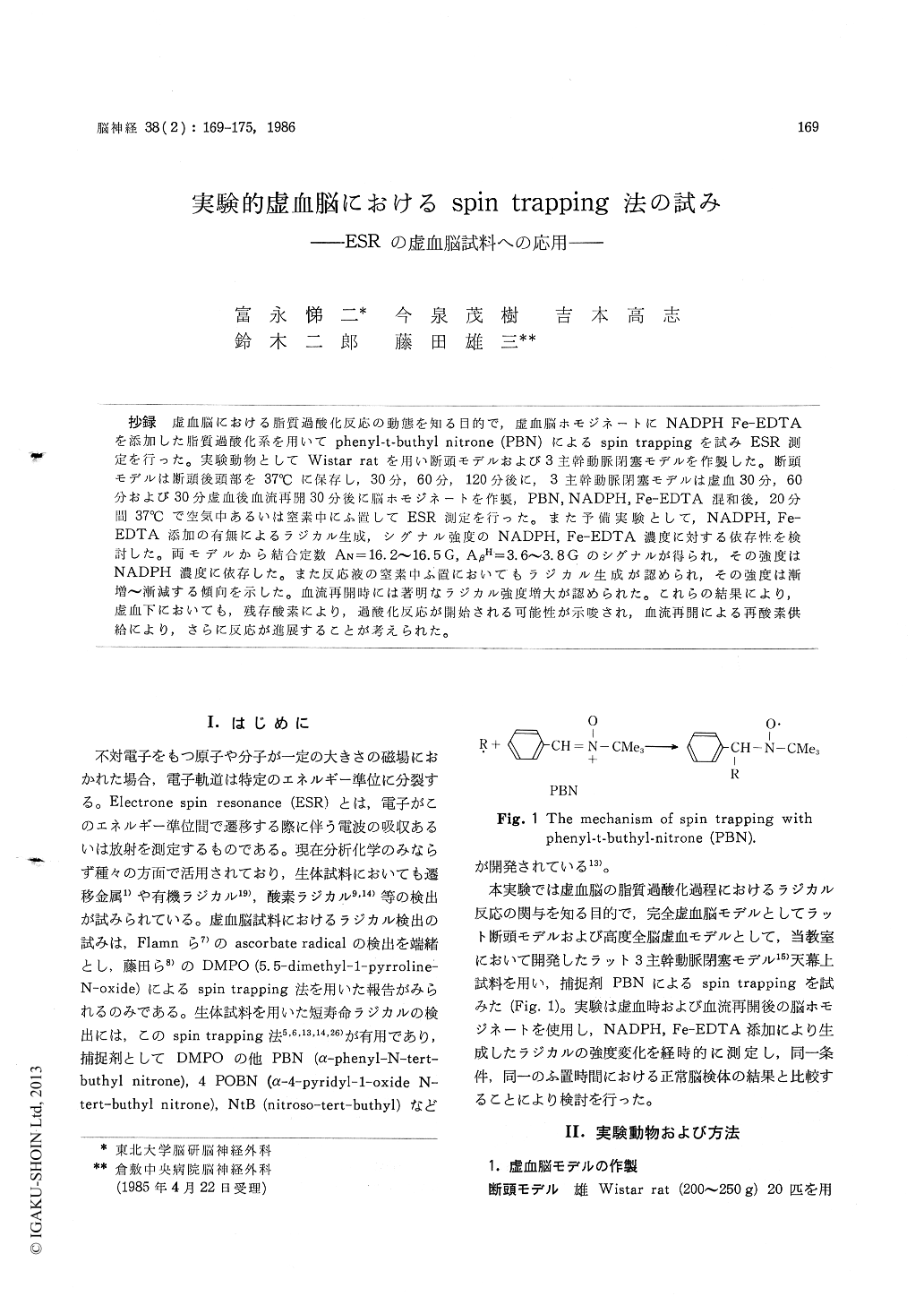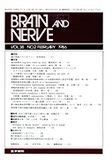Japanese
English
- 有料閲覧
- Abstract 文献概要
- 1ページ目 Look Inside
抄録 虚血脳における脂質過酸化反応の動態を知る目的で,虚血脳ホモジネートにNADPH Fe-EDTAを添加した脂質過酸化系を用いてphenyl-t-buthyl nitrone (PBN)によるspin trappingを試みESR測定を行った。実験動物としてWistar ratを用い断頭モデルおよび3主幹動脈閉塞モデルを作製した。断頭モデルは断頭後頭部を37℃に保存し,30分,60分,120分後に,3主幹動脈閉塞モデルは虚血30分,60分および30分虚血後血流再開30分後に脳ホモジネートを作製,PBN, NADPH, Fe-EDTA混和後,20分間37℃で空気中あるいは窒素中にふ置してESR測定を行った。また予備実験として,NADPH, Fe-EDTA添加の有無によるラジカル生成,シグナル強度のNADPH,Fe-EDTA濃度に対する依存性を検討した。両モデルから結合定数AN=16.2〜16.5G, AβH=3.6〜3.8Gのシグナルが得られ,その強度はNADPH濃度に依存した。また反応液の窒素中ふ置においてもラジカル生成が認められ,その強度は漸増〜漸減する傾向を示した。血流再開時には著明なラジカル強度増大が認められた。これらの結果により,虚血下においても,残存酸素により,過酸化反応が開始される可能性が示唆され,血流再開による再酸素供給により,さらに反応が進展することが考えられた。
Spin trapping technique has been applied to the detection of free radicals generated in NADPHstimulated lipid peroxidation process in ischemic brain homogenate.
Using male Wistar rats, complete cerebral ische-mia for 30 min, 60 min or 120 min was produced by decapitation followed by preservation of the heads at 37゚C. Global cerebral ischemia of 30 min or 60 min duration was induced by occlusions of three vessels (bilateral common carrotid and ba-silar artery) in the ventilated rats. In some ani-mals, bilateral carotid occlusions were released for 30 min following 30 min of ischemia to study postischemic event. Two reaction mixtures contain-ing of brain homogenate, NADPH, Fe-EDTA and spin trapping reagent, phenyl-t-buthylnitrone (PBN), were prepared from each brain sample-one to be incubated in air and the other to be incu-bated in nitrogen gas. After the incubation for 20 min at 37°C, free radical adducts of PBN were measured by electrone spin resonance (ESR).
In preliminary experiments, no ESR signals were obtained from the reaction mixtures without the addition of NADPH and Fe-EDTA. And the dependence of ESR signal intensity upon the NADPH concentration was observed.
The six-line signals (triplet of doublets), which hyperfine splitting constants were AN = 16.2-16.5 G and AβH= 3.6-3.8 G, were obtained from both ischemic models. These signals were dependent upon the presence of oxygen in the reaction sys-tems, as evidenced by the fact that the signal in-tensity obtained from aerobic incubation was con-sistently stronger than that obtained from anae-robic incubation in each brain sample. In decapi-tation models, the intensities of ESR spectra were sequentially increased with the ischemic period under aerobic incubation, and increased gradually for 60 min of ischemic period and then decreased under anaerobic incubation. In three-vessel occlu-sion models, the intensities of ERS spectra reach-ed their peaks at the point of 30 min of ischemic period under both aerobic and anaerobic incuba-tions, furthermore markedly increased during post-ischemic recirculation. These results imply that ischemic injury may make the brain very suscep-tible to lipid peroxidation and that, if there is sufficient supply of oxygen, the reaction will readi-ly progress.

Copyright © 1986, Igaku-Shoin Ltd. All rights reserved.


